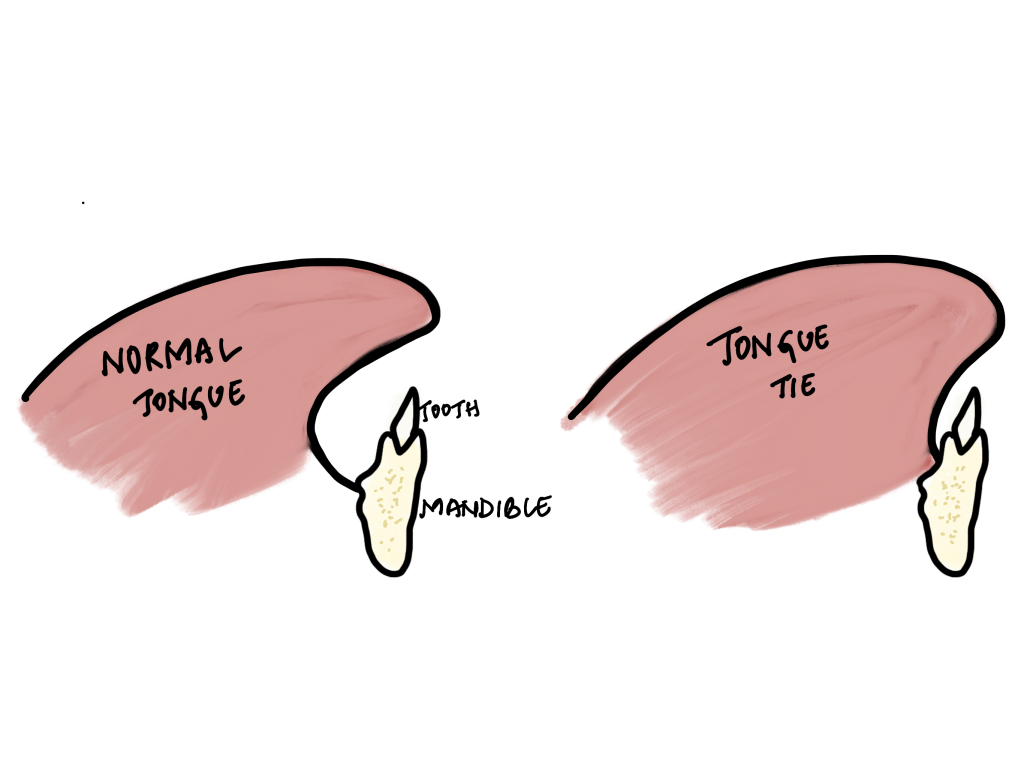Tongue Tie In Newborn – An Ultimate Guide

Tongue-tie is the condition in which the child has a lingual frenulum that is abnormally attached and limiting the free movement of the tongue.
This article will share all the essential facts about the tongue tie in a comprehensive way.
What Is Tongue-Tie
Tongue Tie condition that restricts the movement of the tongue. It is also known as Ankyloglossia.
It is a congenital malformation which means the condition occurred at birth.
The restriction of tongue movement is due to the short, tight, and thick lingual frenulum.
The tongue can move up, down, and side-wise. It can reach any corner of your mouth. The functions of the tongue, to a great degree, is depending on its movement.
The tongue tie is familial, and there is a genetic association. The tongue tie is an X-linked disorder.
The overall incidence of tongue-tie is around 4 to 5 % of kids. It is considerably more common in boys than girls. There is a recent increase in the diagnosis of tongue-tie as there is more emphasis on lactation. And most of the infants with tongue-tie presents with difficulty in feeding.
Often, the tongue tie is associated with lip ties and buccal ties. The association is together called tethered oral tissues.

What Are The Uses Of Tongue
The main functions of the tongue are
Mastication
It is a process of chewing the food with teeth. The cheek and the tongue help the teeth while chewing food.
Deglutition
It is the process of swallowing the chewed food. First, the tongue presses against the anterior and posterior palate to build the pressure. Next, the pressure drives the food from the oral cavity to the esophagus through the pharynx.
Tasting
The tongue has rich nerves to help detect the taste and transmit the taste signal to the brain. Sweet, Sour, Bitter, and Salty are the four primary tastes.
Speech
The tongue is a crucial articulator of speech. The tongue tip continually touches the alveolar ridge to form consonant sounds.
Sound Production
The movement of the tongue along with lips changes the airflow and produces a different variety of sounds.
Facial Formations
The tongue also helps in the dental arch shape formation, growth, and facial formation.
All the functions of the tongue depends on the movement of the tongue except taste sensation. Thus tongue-tie limits all these actions.

Signs Of Tongue Tie
Difficulty in breastfeeding is the presenting complaint in the majority of the infants with tongue-tie.
The tight frenulum prevents movements over the gums, lower lips, and outside the mouth. As a result, it can cause feeding problems too.
Breastfeeding With Tongue Tie
The tongue is helpful during breastfeeding. The newborn will extends its tongue out to take the nipple and some of the areola to suck milk while breastfeeding.
The tongue also helps in latching by forming a good seal during feeding. Unfortunately, the newborn will use the jaw instead of the tongue in the tongue tie for latching and hurts the nipples.
Tongue-tie has the following consequences in mother
- Painful breastfeeding
- Sore nipples
- Repeated mastitis
- Long duration of feeding sessions
- Breast engorgement
Tongue-tie has the following breastfeeding consequences in an infant
- Poor infant weight gain
- Unable suck pacifiers
- Milk may dribble from the mouth.
- Reflux or spitting of milk
- Irritable and frustrated as unable to drink milk while hungry
- Mouth breathing
- Noisy breathing
Explain the importance of exclusive breastfeeding to all young mothers during their prenatal checkups.
Thus detection of more cases these days as there is much emphasis on lactation up to 6 months.
The lactation consultants are the first ones to notice that the infant has a tongue tie.
Sometimes the pediatrician or the nurse can also pick up the presence of tongue-tie in an infant.

Treatment Of Tongue Tie
The tongue tie affects the infant in many ways. Thus it is treated as soon as diagnosed.
The mother trying to change the positions during breastfeeding or change in the latching techniques will not help with the breastfeeding difficulty. Likewise, switching the infant to formula feed will not solve the problem.
The surgery is required to get relief from a tongue tie.
In this procedure, the doctor clips the frenulum for the free movement of the tongue. The clipping will not be very painful. Advise the mother to start breastfeeding to soothe the child. Breastfeeding will also help in the healing process.
Many parents have conveyed that there was an increase in the consumption of milk by infants.
Within two weeks of duration, they noticed better attachment while latching and a tremendous decrease in the pain while breastfeeding.
The procedure is done under anesthesia, and specialized tools are used to cut the frenulum.
Tongue Tie Surgery Complications
General complications of the surgery are
- Bleeding due to arterial damage
- Asphyxia
- Damage to salivary glands
- Damage to tongue

Consequence Of Untreated Tongue Tie
If the tongue-tie is untreated, then there can be consequences like
- Narrow palate
- Crooked teeth
- Speech issues
- Unable to lick the cone icecream
- Unable to kiss
- Increased incidence of cavities
- They find it trouble to roll letters like r, l, d, n, s, etc.
- Gaging and choking on food when the solids are introduced
- Poor oral hygiene during their childhood days
- Bullying by peers due to poor dental hygiene or difficulty in pronunciation due to speech defects
Tongue Tie And Early Weaning
In few cases, the tongue-tie can go unnoticed, and the mother will wean the child early.
The few reasons for the mother to start weaning very early are ineffective latching, mastitis, painful breastfeeding, and inadequate milk transfer.
The early weaning in infants has the following consequences.
- Slow weight gain
- Dehydration
- Prone to infections
- Cavities
- Allergies
- Long-tern effects like prone to chronic illnesses like diabetes, heart problems, etc

To Sum Up
The tongue tie infant will present with feeding difficulty, and you should seek help from a lactation consultant today to know the actual problem.
Early intervention will improve breastfeeding and help your little one grow.
Let your sunshine grow happily in a healthy way.
